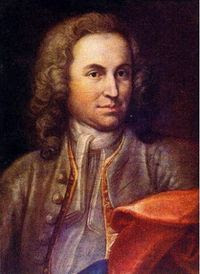 Possibly J.S. Bach at 30 (1715)
Possibly J.S. Bach at 30 (1715)Johann Sebastian Bach (March 21, 1685, Eisenach, Germany – July 28, 1750) was the youngest child of Johann Ambrosius Bach (February 24, 1645 – February 24, 1695),
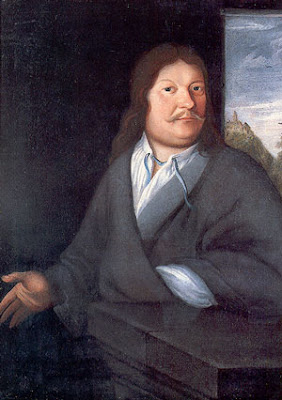
an organist at St. George's Church (who fathered J.S. at 40, and died on his 50th birthday), and Maria Elisabetha Lämmerhirt Bach.
George Frideric Handel was born in the same year in Halle, only about 30 miles from Leipzig, but in 65 years of life J.S. Bach never met him, a fact that Bach appears to have deeply regretted.
J.A. Bach taught J.S. to play violin and harpsichord. The young Bach's uncles were all professional musicians, whose posts ranged from church organists and court chamber musicians to composers. One, Johann Christoph Bach (1645–93), was especially famous and introduced J.S. Bach to organ playing.
Bach's mother died in 1694, and his father eight months later. The 10-year-old orphan moved in with his oldest brother, Johann Christoph Bach (1671–1721), the organist at nearby Ohrdruf. There, he copied, studied and performed music, and apparently received valuable teaching from his brother, who instructed him on the clavichord.
J.C. exposed J.S. to the works of the great South German composers, such as Johann Pachelbel (under whom Johann Christoph had studied) and Johann Jakob Froberger; possibly to the music of North German composers, to Frenchmen, such as Jean-Baptiste Lully, Louis Marchand, Marin Marais; and to the Italian clavierist Girolamo Frescobaldi. Bach's obituary indicates that he copied music out of Johann Christoph's scores, but his brother had apparently forbidden him to do so, possibly because scores were valuable and private commodities at the time.
At 14, Bach, along with his older school friend George Erdmann, was awarded a choral scholarship to study at St. Michael’s School in Lüneburg, not far from the northern seaport of Hamburg, one of the largest cities in the Holy Roman Empire.
This involved a long journey with his friend, probably undertaken on foot and by coach. In addition to singing in the a cappella choir, it is likely that he played the school’s three-manual organ and its harpsichords, learned French and Italian, and received a thorough grounding in theology, Latin, history, geography, and physics.
A decidedly North German influence was exerted by Georg Böhm, with whom Bach came into contact in Lüneburg. It is very probably that while in Lüneburg, Bach would have visited Johanniskirche (St. John's Church and heard (even played) the church's organ (1549, Jasper Johannsen and nicknamed the "Böhm organ" after its most prominent master), an instrument whose sonic capabilities could well have been the inspiration for the mighty Toccata and Fugue in D minor.
It is likely that during this stage he became acquainted with the music of the German organ schools, especially the work of Dieterich Buxtehude, and with music manuscripts and treatises on music theory that were in the possession of these musicians.
In January 1703, shortly after graduating, Bach took up a post as a court musician in the chapel of Duke Johann Ernst in Weimar, a large town in Thuringia. His role appears to have included menial, non-musical duties.
During his seven-month tenure at Weimar, his reputation as a keyboard player spread. He was invited to inspect and give the inaugural recital on the new organ at St Boniface’s Church in Arnstadt.
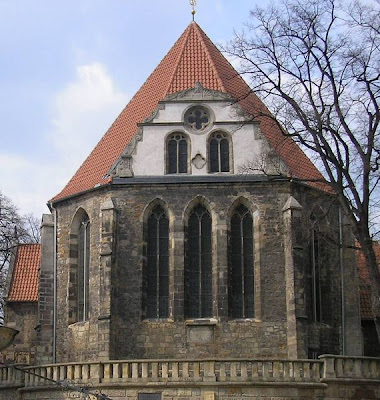
The Bach family had close connections with this oldest town in Thuringia, southwest of Weimar at the edge of the great forest. In August 1703, he accepted the post of organist at Arnstadt, with light duties, a relatively generous salary, and a fine new organ tuned to a modern system that allowed a wide range of keys to be used. At this time, Bach was embarking on the serious composition of organ preludes; these works, in the North German tradition of virtuosic, improvisatory preludes, already showed tight motivic control (where a single, short music idea is explored cogently throughout a movement).
Bach was best known during his lifetime as an organist, organ consultant, and composer of organ works in both the traditional German free genres such as preludes, fantasias, and toccatas, and stricter forms such as chorale preludes and fugues. He established a reputation at a young age for his great creativity and ability to integrate foreign styles into his organ works. Around this time, Bach copied the works of numerous French and Italian composers to gain insights into their compositional languages, and later arranged violin concertos by Vivaldi and others for organ and harpsichord.
Strong family connections and a musically enthusiastic employer failed to prevent tension between the young organist and the authorities after several years in the post. He was apparently dissatisfied with the standard of singers in the choir; more seriously, there was his unauthorised absence from Arnstadt for several months sometime between 1704 and 06, when he visited the great master Dieterich Buxtehude and his Abendmusik in the northern city of Lübeck. This well-known incident in Bach’s life involved his walking some 250 miles each way to spend time with the man he probably regarded as the father-figure of German organists. The trip reinforced Buxtehude’s style as a foundation for Bach’s earlier works, and he overstayed his planned visit by several months.
***
The Toccata and Fugue in D Minor, BWV 565 (c. 1706), is commonly attributed to J.S. Bach.

While the work uses the key signature of D Dorian, it is written solidly in D Harmonic Minor. The Toccata begins with a single-voice flourish in the upper ranges of the keyboard, doubled at the octave. The motive then spirals downward, where a diminished seventh chord appears, in ascending arpeggiation. The flourish resolves with a picardy (raised) 3rd as a D major chord, a borrowing from tonic major.
The subject of the four-voice Fugue is made up entirely of sixteenth notes, with an implied pedal point set against a brief melodic subject that first falls, then rises. The second entry starts in the subdominant, rather than the dominant. Although unusual for a Bach fugue, this is a real answer and is appropriate following a subject that progresses from V to I and then to V below I by a leap.
The source of the rhapsodic treatment in Bach's earlier organ works is reminiscent of Dieterich Buxtehude, whom Bach greatly admired in his early years.
Buxtehude's organ works, like those of his contemporaries, are characterized by the presence of the stylus phantasticus, a performance style derived from improvisation, which elements of excitement and bravura, with adventurous harmonies and sudden changes in registration.
Such works generally began with a free section, followed by an imitation (sometimes a full fugue), then another free section, and a second imitative section (usually based on motivic material from the previous imitation), and a concluding free section.
In the Fugue, the F major episode (an elaboration of the Fugue subject) is nearly identical to a passage in a Fantasia in D Minor by Johann Pachelbel, which is also is the source for the subject, and the borrowing is possibly an homage to the older composer.
As noted in J. S. Bach's obituary, it was common practice for the composer to use other's works as inspiration for his own.
The exceptional number of fermatas and broken chords in the Toccata and Fugue BWV 565 has been explained by some on the supposition that Bach composed it as a work to test an organ, which he did regularly, by pulling out all the stops and play in the fullest possible texture.
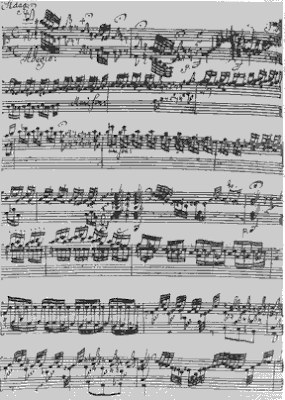
Peter Williams claims that the copyist who created the oldest known manuscript (Johannes Ringk, 1717-1778) was a student of Bach's, had access to some of Bach's manuscripts, and a reputation that was dubious. He is believed to have passed off inauthentic (as well as authentic) works under the composer's name. The Toccata and Fugue abounds in fermatas and dynamic markings, not ordinarily notated in organ music of Bach's day (but Bach even at this time was unusual in notating much ornamentation).
Christoph Wolff , Helmut Walcha, and others argue that the work is indeed by Bach, and is probably a transcription of an improvisation.
It is very unlikely that Ringk would have had knowledge of the work by Pachelbel to which Bach alludes, and there is no proof of the student-teacher relationship. Very few of Bach's organ works survive in autograph score and many were discarded after they had been stylistically or structurally superseded as the composer's style matured. Further, Bach occasionally wrote consecutive fifths (crudities cited by Williams, for example, in the Brandenburg Concerto No. 5 , later "corrected" to hidden octaves), and used imperfect fifths (e.g. diminished fifth to perfect fifth) in his vocal works (the latter are not avoided unless appearing between soprano and bass.
Williams has also argued that the Toccata and Fugue was transcribed by Bach from an earlier work for violin. Bach is known to have transcribed solo violin works for organ at least twice. The Prelude first movement of the Partita in E Major for solo violin, BWV 1006, was converted by Bach into the solo organ part of the opening movement of the Cantata BWV 29 "Wir danken dir, Gott, wir danken dir." Bach also transcribed the Fugue movement of his Sonata in G Minor for solo violin BWV 1001 as the second half of the Prelude and Fugue in D Minor for organ, BWV 539.
Around the end of the 19th century a "second wave" Bach revival occurred (the first having been the one launched earlier in the 19th century by Mendelssohn among others), when much of Bach's instrumental music was adapted to resources that were available in salon settings (e.g. solo piano or chamber ensembles). Composer-pianist Ferruccio Busoni (1866-1924) wrote many piano transcriptions of Bach compositions, which often radically alter the original, among them, the Toccata and Fugue. Other arrangements have appeared by Percy Grainger and Ignaz Friedman.
The Disney film Fantasia (1940) opens with Leopold Stokowski's 1927 transcription for large orchestra of the Toccata and Fugue, in a time before authentic performance practice considerations.
The "Haunted House" associations of this music have been emphasized in a film of Gaston Leroux's novel The Phantom of the Opera (1962) and Fellini's La Dolce Vita, where Steiner plays the piece on a church organ. In Disney's cinematic 20,000 Leagues Under The Sea Captain Nemo plays the work on his organ.
Virgil Fox performed the Toccata and Fugue as part of a series of Bach organ concerts in the 1970's, entitled Heavy Organ.
***
Despite his comfortable position in Arnstadt, by 1706 Bach appeared to have realised that he needed to escape from the family milieu and move on to further his career. He was offered a more lucrative post as organist at St Blasius’s in Mühlhausen, a large and important city to the north. The following year, he took up this senior post with significantly improved pay and conditions, including a good choir.
Four months after arriving at Mühlhausen, Bach married his second cousin Maria Barbara Bach in 1707, with whom he had seven children, four of which survived to adulthood. The two of the elder sons became composers of renown; the third ultimately abandoned music for law and died in his 20's.
Catharina Dorothea (December 28, 1708 – January 14, 1774).
Wilhelm Friedemann (November 22, 1710 – July 1, 1784).
Carl Philipp Emanuel (March 8, 1714 – December 14, 1788).
Johann Gottfried Bernhard (May 11, 1715 – 27 May 27, 1739).
***
Bach subsequently subtitled the Organ Fugue in G Minor ("Little"), BWV 578 (c. 1707) to avoid confusion with the later "Great" Fantasia and Fugue in G Minor, BWV 542, which has a longer duration.

The Little Fugue's four-and-a-half measure can be solfeged as
Do Sol Me Re Do Me Re Do Ti Do Sol
Do Sol Re Sol Me Re Do Re Sol
Do Sol Do Re Sol Re Me Re Do Re Sol
Note the clear outline of the tonic minor triad, use of harmonic minor, the insistent utterances of the dominant and outline of the Do-Re minor third, and the through-composed spilling out of the notes, which leads to the subject being transformed into the counter-subject as the answer begins in the alto part on the 5th degree (Sol) of the scale (stated a 4th below the original subject.
While the fugue is in four voices, it limits itself to a maximum of three at a time, save for full expression at approximately 4/5 through the piece and at its conclusion.
The initial structure is
A soprano (subject on tonic)
A' alto (answer on dominant, stated a 4th below the tonic -
with soprano continuing as countersubject)
B brief episode (1 1/2 bars)
A'' tenor (subject on tonic, transposed down an octave -
with two countersubjects in soprano and alto that must be played by one hand)
A'''' bass (answer on dominant, transposed down an octave from the alto version, played entirely by foot pedals - with soprano and tenor on countersubjects)
B' longer episode (3 bars)


During the episodes, Bach uses one of Arcangelo Corelli's most famous techniques: imitative call-and-response between two voices on an eighth note upbeat figure that first leaps up a fourth and then falls back down one step at a time, initially stated on the dominant as A D C Bb (Sol Do Te Le)
The conclusion features a dominant drone -- often called a "pedal point," but here in the alto voice. The final chord utilizes the Piccardy third, raising the Me to Mi, for a happy-ending G major chord.
***
The church and city government at Mühlhausen readily agreed to Bach's plan for an expensive renovation of the organ at St Blasius’s, and were so delighted at the elaborate, festive cantata he wrote for the inauguration of the new council in 1708 -- God Is my King BWV 71, clearly in the style of Buxtehude -- that they paid dearly for its publication, and twice in later years had the composer return to conduct it. However, that same year, Bach was offered a better position in Weimar.
Weimar (1708–17)
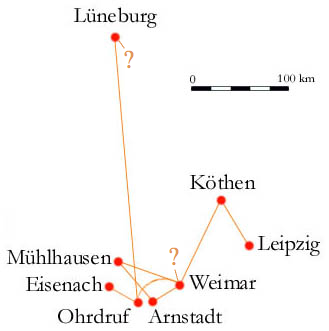
After barely a year at Mühlhausen, Bach left to become the court organist and concert master at the ducal court in Weimar, a far cry from his earlier position there. The generous salary and prospect of working entirely with a large, well-funded contingent of professional musicians may have prompted the move. The family moved into an apartment a short walk from the ducal palace.
Bach's most productive organ period, the years at Weimar (1708–14) saw the composition of several pairs of preludes and fugues, toccatas and fugues,
In the following year (1709), Bach's first child, Wilhelm Friedemann, was born and they were joined by Maria Barbara’s elder, unmarried sister, who remained with them to assist in the running of the household until her death in 1729.
***
The autograph manuscript of Passacaglia and Fugue in C Minor, BWV 582 (c. 1713) is considered lost; the work, as is typical for Bach and his contemporaries, is known only through a number of copies. There is some evidence that the original was notated in organ tablature.
The first half of the Passacaliga's ostinato (the repeating bass pattern upon which variations are generated) also serves as the fugue's main subject, and was most probably taken from a short work by André Raison.

The middle staff above is Bach's theme in C Harmonic Minor (Do Sol Me Fa Sol Le Fa So Re Me Ti Do Fa Sol Do); the upper and lower of Raison, specifically Organ Book I: Mass on the Second Tone: Christe - Trio in Passacaglia and Mass on the Sixth Tone: Christe - Trio in Chaconne). Harmonization is a schematic after the first variation.

Others dispute the Raison connection, and Bach's work shares features with other north German ostinati, notably Buxtehude's two Chaconnes (BuxWV 159–160) and a Passacaglia (BuxWV 161); further, there is clear influence of Pachelbel's chaconnes in several variations and the overall structure.
Although BWV 582 is now most commonly played on organ, it is not clear whether it was composed for such, or a double manual harpsichord or clavichord; the original manuscript may not have had pedal cues.
The Passacaglia is in 3/4 time typical of the form. Bach's ostinato comprises eight bars (an ostinato of the same length is used in Johann Krieger's Organ Passacaglia). The opening consists of the monophonic ostinato stated in the pedal, and such a device may even have been used by Buxtehude as well.
There are 20 variations in BWV 582/1. The first begins with a typical C minor affekt, "a painful longing" (Spittaf) similar to the beginning of Buxtehude's Chaconne in C Minor (BuxWV 159).
Some have speculated that there is a symbolic component to the structure: Martin Radulescu argues that it is "in the form of a cross."
The Passacaglia builds up until its climax in variation 12.
This is followed by three quiet variations, forming a short intermezzo, and a concluding five variations.
Marie-Claire Alain (Bach: Complete Organ Works, vol.14, Erato) notes that the 21 variations are broken down into 7 groups of 3 similar variations, each opening with a quotation from a Lutheran chorale, treated similarly to the contemporaneous Orgel-Buchlein, the bars as follows:
8-12, the top part spells out the opening notes of "Nun komm' der Heiden Heiland"
24-48, a cantilena spells out "Von Gott will ich nicht lassen"
49-72, the scales are a reference to "Vom Himmel kam der Engel Schar"
72-96, recalling the "star" motif from "Herr Christ, der Ein'ge Gottes-Sohn"
96-120, ornamented figure similar to that in "Christ lag in Todesbanden" accompanies theme in the soprano then moving successively to alto and bass
144-168 "Ascending intervals in bass recall the Easter chorale "Erstanden ist der heil'ge Christ".
Additionally, he numbers Passacaglia ground repetitions (21) and statements of the Fugue subject (12) are bass-ten "inversions."
The Passacaglia is followed, without break, by a double Fugue. The first half of the passacaglia ostinato is used as the first subject; a transformed version of the second half is used as the second subject. Both are heard simultaneously in the beginning of the fugue. A countersubject enters immediately afterwards and is then used throughout the piece. When the three subjects appear simultaneously, they never do so in the same combination of voices twice; this therefore is a permutation fugue, possibly inspired by Johann Adam Reincken's works.
As the Fugue progresses, Bach ventures into major keys (Eb and Bb) and the time between the statements increases from 1-3 bars to 7-13. This expansion culminates in a Neapolitan sixth chord that leads into the 18-bar coda.
Robert Schumann described the variations of the Passacaglia as "intertwined so ingeniously that one can never cease to be amazed," and indeed this work became an important influence on 19th and 20th century passacaglias.
The Passacaglia was transcribed for orchestra by Leopold Stokowski, and for piano by a number composers/pianists, including Eugene d'Albert, Max Reger (two pianos), and Awadagin Pratt.
An arrangement of some initial parts of the Passacaglia is presented two times in the Baptism sequence of The Godfather, together with other organ pieces and the ending of the Präludium BWV 532, that concludes the Baptism sequence.
A small segment of the work, in piano transcription of Eugene d'Albert, is played in the Life Aquatic with Steve Zissou, performed by Angela Hewitt.
***
Bach’s position at Weimar marked the start of a sustained period of composing keyboard and orchestral works. From the music of Italians such as Vivaldi, Corelli and Torelli -- he learned how to write dramatic openings and adopted sunny dispositions, dynamic motor-rhythms and decisive harmonic schemes. Bach inducted himself into these stylistic aspects largely by transcribing for harpsichord and organ the ensemble concertos of Vivaldi. He may have picked up the idea of transcribing the latest fashionable Italian music from Prince Johann Ernst, one of his employers, who was a musician of professional calibre. In 1713, the Duke returned from a tour of the Low Countries with a large collection of scores, some of them possibly transcriptions of the latest fashionable Italian music by the blind organist Jan Jacob de Graaf. Italianate features can be heard in the Prelude from English Suite No. 3 for harpsichord (1714).
Carl Philipp Emanuel Bach was born that same year on March 8, 1714.
During his tenure at Weimar, Bach started work on Orgel-Buchlein (The Little Organ Book, 1717, for Wilhelm Friedemann), an unfinished collection of 45 short chorale preludes that demonstrate compositional techniques in the setting of chorale tunes. The book illustrates two major themes in Bach’s life: his dedication to teaching and his love of the chorale as a musical form.

Cothen (1714-1723)
At this time, Prince Leopold, himself a musician, of Anhalt-Cöthen hired Bach to serve as his Kapellmeister. As the prince Calvinist (a tradition requiring only simple musical expression in services), most of Bach’s work at this time was secular.
***
Trio Sonata for Two Flutes and Continuo (BWV 1039)
I. Adagio
II. Allegro ma non presto
III. Adagio e piano
IV. Presto
***
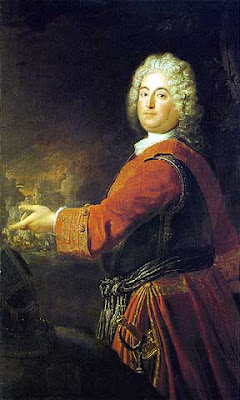
[Christian Ludwig of Brandenburg-Schwedt (1710, Antoine Pesne)]
The Brandenburg Concertos or Six Concerts Avec plusieurs Instruments, BWV 1046–1051) are six concerto grossi presented by Bach to Christian Ludwig, margrave of Brandenburg-Schwedt, in 1721, though composed from 1717 on.
Each is for a different scoring (the first rewritten for a special occasion), tallying with the players at Bach's disposal in Cöthen.
The dedication reads:
"As I had the good fortune a few years ago to be heard by Your Royal Highness, at Your Highness's commands, and as I noticed then that Your Highness took some pleasure in the little talents which Heaven has given me for Music, and as in taking Leave of Your Royal Highness, Your Highness deigned to honour me with the command to send Your Highness some pieces of my Composition: I have in accordance with Your Highness's most gracious orders taken the liberty of rendering my most humble duty to Your Royal Highness with the present Concertos, which I have adapted to several instruments; begging Your Highness most humbly not to judge their imperfection with the rigor of that discriminating and sensitive taste, which everyone knows Him to have for musical works, but rather to take into benign Consideration the profound respect and the most humble obedience which I thus attempt to show Him."
Because King Frederick William I of Prussia was not a significant patron of the arts, Christian Ludwig seems to have lacked the musicians in his Berlin ensemble to perform the concertos. The full score was left unused in the Margrave's library until his death in 1734, when it was sold for 24 groschen (as of 2008, about $22.00). The concertos were discovered in the archives of Brandenburg in the 19th century.
In the modern era these works have been performed by orchestras with the string parts each played by a number of players, under the batons of, for example, Karl Richter and Herbert von Karajan. They have also been performed as chamber music, with one instrument per part, especially by (but not limited to) groups using baroque instruments and historically-informed techniques and practice.
1685Bach1717BrandenburgConcerto01
Brandenburg Concerto No. 1 in F Major, BWV 1046 (c. 1717)
Title on autograph score: Concerto 1mo à 2 Corni di Caccia, 3 Hautb: è Bassono, Violino Piccolo concertato, 2 Violini, una Viola è Violoncello, col Basso Continuo.
3 Oboes, 1 Bassoon, 2 Corni da Caccia (Hunting Horns)
Violino Piccolo, 2 Violins, Viola, Cello, Basso Continuo
I. [Allegro]
II. Adagio
III. Allegro
IV. Menuet - Trio I - Menuet da capo - Polacca - Menuet da capo - Trio II - Menuet da capo
This concerto is the only one in the collection with four movements. The first movement can also be found as the sinfonia of the Cantata No. 52 "Falsche Welt, dir trau ich nicht." The third was used as the opening chorus of Cantata No. 207. An earlier version (Sinfonia, BWV 1046a), minus violino piccolo, was used for the opening of Cantata No. 208, lacking the third movement and the Polacca from the final movement (Menuet - Trio I - Menuet - Trio II - Menuet).
Brandenburg Concerto No. 1 features actual horn calls in its first movement, in ritournello form -- a rondo-like structure, where the main thematic material returns in fragmentary forms.
I [Allegro]
Trevor Pinnock
Christopher Hogwood
The four Orchestral Suites or Ouvertures (BWV 1066–1069) are examples of the baroque suite, a French overture (slow dotted rhythms leading to a fugue) followed by a series of characteristic dances.
Orchestral Suite No. 1 in C Major, BWV 1066 (c. 1717)
Oboe I-II, Bassoon, Violin IiII, Viola, Basso Continuo
Ouverture
Courante
Gavotte I/II
Forlane
Minuet I/II
Bourrée I/II
Passepied I/II
Brandenburg Concerto No. 2 in F Major, BWV 1047 (c. 1718)
Title on autograph score: Concerto 2do à 1 Tromba, 1 Fiauto, 1 Hautbois, 1 Violino concertati, è 2 Violini, 1 Viola è Violone in Ripieno col Violoncello è Basso per il Cembalo
Concertino: Block Flute (Recorder), Oboe, F Trumpet, Violin
Ripieno: Violin I-II, Viola, Violone (Cello), and Basso Continuo (including Harpsichord)
I. [Allegro]
II. Andante
III. Allegro assai
This piece was no doubt written with the court trumpeter Johann Ludwig Schreiber, and is still considered one of the most difficult in the entire repertoire, played on either the natural or the modern valved instrument.
The trumpet does not play in the second movement, as is common practice in baroque era concerti due to the construction of the instrument, which allows the trumpet to play only in one key. Because concerti often move to a different key in the second movement, the trumpet is unable to play.
This piece was also chosen to be the first on the list of compositions to be played on the "Golden Record," a phonograph album containing a broad sample of planet Earth's common sounds, languages, and music. The record was sent into outer space with the Voyager probe launched September 5, 1977 in hopes that some intelligent extraterrestrial species might find and decode its contents.
I. [Allegro]
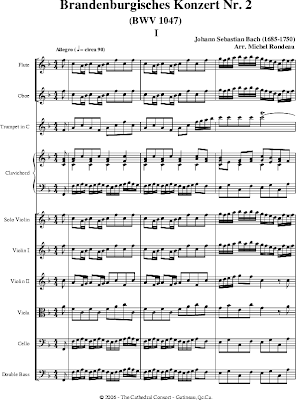
Brandenburg Concerto No. 3 in G Major, BWV 1048 (c. 1719)
Title on autograph score: Concerto 3zo a tre Violini, tre Viole, è tre Violoncelli col Basso per il Cembalo.
Violin I-III, Viola I-III, Cello I-III, and Basso Continuo (including Harpsichord)
I. Allegro
II. Adagio
III. Allegro
The first movement can also be found in reworked form as the Sinfonia of the Cantata No. 174 "Ich liebe den Höchsten von ganzem Gemüte," with the addition of three oboes and two horns.
The second movement consists of a single measure with the two chords that make up a Phrygian mode cadence and it was likely that these chords are meant to surround or follow a cadenza improvised by a harpsichord or violin player. Modern performance approaches run a gamut from simply playing the cadence with minimal ornamentation (treating it as a sort of "musical semicolon"), to inserting movements from other works, to cadenzas varying in length from under a minute to over two minutes.

Notably, Walter/Wendy Carlos's three electronic performances (from Switched-On Bach, Switched-On Brandenburgs, and Switched-On Bach 2000) on

Moog synthesizer have second movements that are completely different from each other.
Occasionally the third movement Largo from Bach's Sonata for Violin and Continuo in G (BWV 1021) is substituted for the second movement as it contains an identical Phrygian mode cadence as the closing chords. The Adagio from the Violin Sonata in G (BWV 1019a), has also been used.
I. [Allegro]
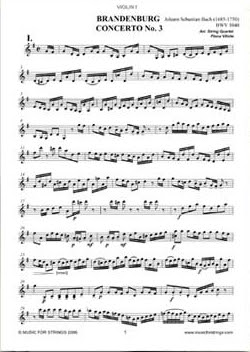
Trevor Pinnock
Walter Carlos
II. Adagio
Trevor Pinnock
Wendy Carlos
III. Allegro
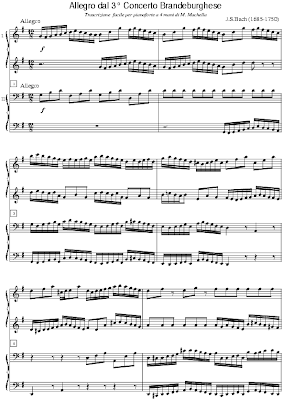
Trevor Pinnock
Wendy Carlos
Trio Sonata for Flute, Violin, and Continuo (c. 1720)
***
On July 7, 1720, while Leopold and Johann Sebastian were away, Bach's wife died suddenly.
The following year, the widower met Anna Magdalena Wilcke, a highly gifted court soprano 17 years his junior, whom he married on December 3, 1721. They had a further 13 children (for a total of 20 for JSB), six of whom survived to adulthood (10 entire), two of which (for a final sum of 4 - the nicknamed ones below) became famous composers. His eldest born from Anna was also a musician, making a final count of six musically gifted male offspring.
Gottfried Heinrich (1724–63)
Elisabeth Juliana Friederica, called "Liesgen" (1726–81)
Johann Christoph Friedrich, the "Bückeburg Bach" (1732–95)
Johann Christian, the "London Bach" (1735–82)
Johanna Carolina (1737–81)
Regina Susanna (1742–1809)
Elisabeth married Bach's pupil Johann Christoph Altnikol.
***
Brandenburg Concerto No. 4 in G Major, BWV 1049 (1721)
Title on autograph score: Concerto 4ta à Violino Principale, due Fiauti d'Echo, due Violini, una Viola è Violone in Ripieno, Violoncello è Continuo
Concertino: Block Flute (Recorder) I-II, Violin
Ripieno: Violin I-II, Viola, Cello, Violone, Basso Continuo
I. Allegro
II. Andante
III. Presto
The violin part of the Brandenburg Concerto No. 4 is extremely virtuosic in the first and third movements. In the second movement, the violin provides a bass when the concertino group plays unaccompanied.
Bach adapted this concerto as the last of his set of six Harpsichord Concerti (scored additionally for two Block Flutes and Strings, in F Major, BWV 1057). As well as taking on most of the solo violin's role, the harpsichord also takes over some of the recorders' parts in the andante, plays a basso continuo at times and occasionally adds a fourth contrapuntal part to an originally three-part texture (something which Bach sometimes did while improvising).
I. Allegro
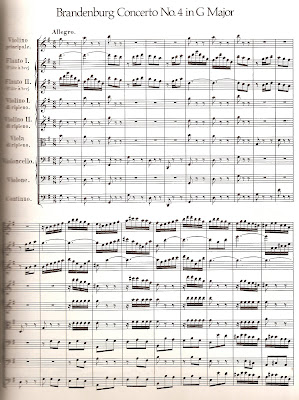
Brandenburg Concerto No. 5 in D Major, BWV 1050 (c. 1721)
Title on autograph score: Concerto 5to d une Traversiere, une Violino principale, une Violino è una Viola in ripieno, Violoncello, Violone è Cembalo concertato
Concertino: Flute, Harpsichord, Violin
Ripieno: Violin, Viola, Cello, Violone
I. Allegro
II. Affettuoso
III. Allegro
The harpsichord in the Brandenburg Concerto No. 5 serves as both concertino and ripieno instrument, in obbligato and figured bass passages.
.
This concerto makes use of a popular chamber music ensemble of the time (flute, violin, harpsichord), which Bach used on its own for the middle movement. The work may have benn written as early as 1719, to show off a new harpsichord by Michael Mietke which Bach had brought back from Berlin for the Cöthen court. It may also have been written for a competition at Dresden vying with the French composer and organist Louis Marchand, as the central movement utilizes one of Marchand's themes (Bach's rival fled before the comp-off could take place, apparently scared off).
The concerto is well suited throughout to showing off the qualities of a fine harpsichord and the virtuosity of its player, but especially in the lengthy solo 'cadenza' to the first movement. It seems well nigh certain that Bach, considered a great organ and harpsichord virtuoso, was the harpsichord soloist at the premiere, and this may have been the birth of solo keyboard concerto.
An earlier version, BWV 1050a, has innumerable small differences from its later cousin, but two main ones: there is no part for cello, and there is a shorter and less elaborate harpsichord cadenza in the first movement. The cello part in BWV 1050, when it differs from the violone part, doubles the left hand of the harpsichord.
I. Allegro

Brandenburg Concerto No. 6 in B-Flat Major, BWV 1051 (1721)
Title on autograph score: Concerto 6to à due Viole da Braccio, due Viole da Gamba, Violoncello, Violone e Cembalo
Viola da Braccio I-II, Viola da Gamba I-II, Cello, Violone, Harpsichord
I. Allegro
II. Adagio ma non troppo
III. Allegro
In the Brandenburg 6, Viola da braccio means the normal viola, and is used here to distinguish it from the "viola da gamba." When the work was written, the gamba was already an old-fashioned instrument. There is a strong supposition that one viola da gamba part was taken by Leopold, and that the composition was written so that the prince would be included amongst the players.
The two violas start the first movement with a vigorous subject in close canon, and as the movement progresses, the other instruments are gradually drawn into the seemingly uninterrupted steady flow of melodic and polyphonic invention.
The two gambas are silent in the second movement, leaving the texture of a trio sonata for two violas and a decorated continuo, featuring cello. In the last movement, the spirit of the gigue underlies everything, as in the fifth concerto.
I. Allegro
Notebook for Anna Magdelena Bach, Book 1 (1722)
Each book of The Well-Tempered Clavier, Book 1 (1722) and 2 (BWV 846–893) comprises a prelude and fugue in each of the 24 major and minor keys (the whole collection is often referred to as ‘the 48’). The “Well-tempered” refers to a tuning system flexible enough to allow composition on every scale degree, related to, or identical with, today's "even temperament."
Ia. Prelude in C Major
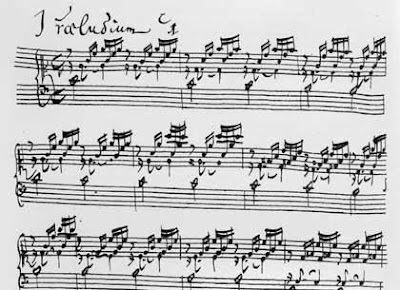
The opening four measures form a nice I ii2 V65 I, followed by a more thorough working out that delays a resolute tonic until the very end. Note the use of mezzo-soprano clef in the upper staff.
(MIDI harpsichord version - excerpt)
Piano Version (Glenn Gould)
Ib. Fugue in C Major
II. Prelude and Fugue in C Minor
1685Bach1722WellTemperedClavier02PreludeAndFugueInCMinor
VII. Fugue in Eb Major
The pedagogical 15 Inventions (1723) and 15 Sinfonias (BWV 772–801), sometimes called 15 Two-Part and 15 Three-Part Inventions are short imitative contrapuntal works arranged in order of key signatures of increasing sharps and flats, omitting some of the less used ones.
It was given a title by Bach: "A faithful Guide, whereby admirers of the harpsichord are shown a plain Method of learning not only to play clean in two Parts, but likewise in further Progress to manage three obbligato Parts well and correctly, and at the same time not merely how to get good Inventions, but also how to develop the same well; but above all, to obtain a cantabile Style of playing, and together with this to get a strong Foretaste of Composition."
The two groups of pieces are both arranged in order of ascending key, each group covering 15 keys, the sequence being
I. C major
II. C minor
III. D major
IV. D minor
V. E-flat major
VI. E major
VII. E minor
VIII. F major
IX. F minor
X. G major
XI. G minor
XII. A major
XIII. A minor
XIV. B-flat major
XV. B minor
I. C Major (Steel Drums)
IV. D Minor
VIII. F Major
XIV. Bb Major
***

Leipzig

(1723-1750)

In 1723, Bach was appointed Cantor of Thomasschule, adjacent to the

Thomaskirche (St Thomas’s Lutheran Church) in Leipzig, as well as Director of Music in the principal churches in the town. This was a prestigious post in the leading mercantile city in Saxony, a neighboring electorate to Thuringia. Apart from his brief tenures in Arnstadt and Mühlhausen, this was Bach’s first government position in a career that had mainly involved service to the aristocracy.

[Bach's Leipzig apartment]
This final post, which he held for 27 years until his death, brought him into contact with the political machinations of his employer, the Leipzig Council. The Council comprised two factions: the Absolutists, loyal to the Saxon monarch in Dresden, Augustus the Strong; and the City-Estate faction, representing the interests of the mercantile class, the guilds and minor aristocrats. Bach was the nominee of the monarchists, in particular of the Mayor at the time, Gottlieb Lange, a lawyer who had earlier served in the Dresden court. In return for agreeing to Bach’s appointment, the City-Estate faction was granted control of the School, and Bach was required to make a number of compromises with respect to his working conditions.
Bach performed a cantata on Sunday at the Thomaskirche, on a theme corresponding to the lectionary readings of the week, as determined by the Lutheran Church Year calendar. He did not perform cantatas during the seasons of Lent and Advent. Although he performed cantatas by other composers, he also composed at least three entire sets of cantatas, one for each Sunday and holiday of the church year, at Leipzig, in addition to those composed earlier at Mühlhausen and Weimar.
In total he wrote more than 300 sacred cantatas, of which only about 195 survive.
His cantatas vary greatly in form and instrumentation -- solo singer, single choruses, grand orchestras, chamber ensembles. A very common format includes a large opening chorus followed by one or more recitative-aria pairs for soloists (or duets), and a concluding chorale.
The recitative is part of the corresponding Bible reading for the week and the aria is a contemporary reflection on it. The melody of the concluding chorale often appears as a cantus firmus in the opening movement. The best known of these cantatas are BWV 4 ("Christ lag in Todesbanden"), BWV 80 ("Ein' feste Burg"), BWV 140 ("Wachet auf") and BWV 147 ("Herz und Mund und Tat und Leben").
***
Cantata No. 29 ("Wir danken dir, Gott")
I Sinfonia
Cantata No. 38 ("Aus Tiefer Not") ("Out of the Depths") (1724)
Cantata No. 80 ("Ein Feste Burg") ("A Mighty Fortress") (1724 )
I. Chorus
VIII. Chorale
Passion According to St. John (1724)
Passion According to St. Matthew (1727)
Orchestral Suite No. 2 (1729)
Orchestral Suite No. 3 (1729)
I. Ouverture
II. Air
Trevor Pinnock
Wendy Carlos
III. Gavotte I/II
IV. Bouree
V. Gigue
***
Although it appears that no one on the Council doubted Bach’s musical genius, there was continual tension between the Cantor, who regarded himself as the leader of church music in the city, and the City-Estate faction, which saw him as a schoolmaster and wanted to reduce the emphasis on elaborate music in both the School and the Churches. The Council never honored Lange’s promise at interview of a large salary of 1,000 talers a year, although it did provide Bach and his family with a smaller income and a good apartment at one end of the school building, which was renovated at great expense in 1732.
Bach’s job required him to instruct the students of the Thomasschule in singing, and to provide weekly music at the two main churches in Leipzig, St Thomas's and St Nicholas's. His post also obliged him to teach Latin, but he was allowed to employ a deputy to do this instead. In an astonishing burst of creativity, he wrote up to five annual cantata cycles during his first six years in Leipzig (two of which have apparently been lost). Most of these concerted works expound on the Gospel readings for every Sunday and feast day in the Lutheran year; many were written using traditional church hymns, such as Wachet auf! Ruft uns die Stimme and Nun komm, der Heiden Heiland, as inspiration.
To rehearse and perform these works at St Thomas’s Church, Bach probably sat at the harpsichord or stood in front of the choir on the lower gallery at the west end, his back to the congregation and the altar at the east end. He would have looked upwards to the organ that rose from a loft about four metres above. To the right of the organ in a side gallery would have been the winds, brass and timpani; to the left were the strings. The Council provided only about eight permanent instrumentalists, a source of continual friction with the Cantor, who had to recruit the rest of the 20 or so players required for medium-to-large scores from the University, the School and the public. The organ or harpsichord were probably played by the composer (when not standing to conduct), the in-house organist, or one of Bach’s elder sons, Wilhelm Friedemann or Carl Philipp Emanuel.
Bach drew the soprano and alto choristers from the boys from the school, and the tenors and basses from there and elsewhere in Leipzig. Performing at weddings and funerals provided extra income for these groups; it was probably for this purpose, and for in-school training, that he wrote at least six motets, mostly for double-choir. As part of his regular church work, he performed motets of the Venetian school and Germans such as Heinrich Schütz, which would have served as formal models for his own motets.
Having spent much of the 1720's composing cantatas, Bach had assembled a huge repertoire of church music for Leipzig’s two main churches. He now wished to broaden his composing and performing beyond the liturgy. In March 1729, he took over the directorship of the Collegium Musicum, a secular performance ensemble that had been started in 1701 by his old friend, the composer Georg Philipp Telemann. This was one of the dozens of private societies in the major German-speaking cities that had been established by musically active university students; these societies had come to play an increasingly important role in public musical life and were typically led by the most prominent professionals in a city. As Christoph Wolff put it, assuming the directorship was a shrewd move that "consolidated Bach’s firm grip on Leipzig’s principal musical institutions."
***

Cantata No. 140 ("Wachet Auf, ruft uns die Stimme")
("Sleepers, Awake"), BWV 140 (1731)
2 Oboes, Taille (similar to oboe da caccia or English horn)
Horn
STB Soloists, Choir
Violino Piccolo, Violin, Viola, Basso Continuo
I. Chorus: Wachet auf, ruft uns die Stimme (Wake up, the voice calls to us)
II. Recitative: Er kommt (He comes)
III. Aria (duet): Wann kommst du, mein Heil? (When will you come, my salvation?)
IV. Chorale: Zion hört die Wächter singen (Zion hears the watchmen singing)
V. Recitative: So geh herein zu mir (So come in with me)
VI. Aria (duet): Mein Freund ist mein! (My friend is mine!)
VII. Chorale: Gloria sei dir gesungen (May "Gloria" be sung to you)
Cantata 140 is based on the Philipp Nicolai's chorale of the same name, a Lutheran hymn that remains popular today both in its original German and in a variety of English translations.
The text is the parable of the ten virgins in Matthew 25:1–13, a reading that was scheduled in the Lutheran lectionary of the time for the 27th Sunday after Trinity.
Because this Sunday only occurred in the church year when Easter was very early, the cantata was rarely performed, but the infrequency of the occasion fmakes it one of the few cantatas whose date of composition is definitively known.
In the modern three-year Revised Common Lectionary, however, the reading is scheduled for Proper 27, or the 32nd Sunday in Ordinary Time, in the first year of the three-year cycle of lessons. The text and its eschatological themes are also commonly associated with the early Sundays of the season of Advent, and so the cantata is also commonly performed during that season.
The seven movements form a rough palindromic (or rondoic, depending on the perception) arch of
A 1. Chorale
B 2. Recitative / 3. Duet
A' 4. Chorale II
B' (or C) 5. Recitative / 6. Duet II
A'' 7. Chorale III
The first movement is a chorale fantasia based on the chorale's first verse -- a common feature of Bach's cantatas. The inherited melody is held out in rhythmically augmented notes as a (boy) soprano cantus firmus, the first tonic 6 triadic phrase of which is
Do Mi Sol Sol Sol Sol La Sol (see movement 7 for the simplest expression of the melody)
against a dotted-rhythm "royal" topic, representing the coming of the Christ bridegroom, and call-and-response eighth-and-sixteenth-note flourishes in other voices and instruments.
1685Bach1731Cantata140
The second movement is a recitative for tenor
that precedes the third movement, a duet for soprano (the soul) and bass (Jesus) with obbligato violin.
The fourth movement, on the chorale's second verse, is a trio sonata for upper strings (oboe da caccia?), tenors, and continuo.
Early Music performance, conducted by John Elliot Gardiner
Moog Synthesizer, performed by Walter Carlos
Bach later transcribed this movement for organ (BWV 645), and it was subsequently published along with five other transcriptions Bach made of his cantata movements as the Schübler Chorales.
The fifth movement is a recitative for bass,
preceding the sixth -- which is another love duet for soprano (soul) and bass (Jesus) with obbligato oboe (such a scenario will also resonate with 19th-century hymn writers, and Olivier Messiaen).
The final section, as with many of Bach's cantatas, is based on the chorale's last verse in artful, straightforward four-part harmonization, seemingly implying that the congregation could join in with the choir. As an added gebrauschtmusik (Paul Hindemith's later term for practical workaday music) touch, the instruments double the singers for ease of sing-along.

First phrase Theoretical Close-Up....
Soprano: Do Mi Sol Sol Sol Sol La Sol
Bass: Do Mi Sol Fa Mi Re Do Ti Do La Re Sol
Harmony:
Eb Eb/G Bb PT Eb/G PT PT Bb/D Cm7/Eb Cm7 F Bb
I I6 V PT I6 PT PT V6 vi65 vi7 II (V of V) V
***
Cantata No. 147 (Herz und Mond und Tat und Leben)
"Jesu, Joy" - Wendy Carlos
Cantata No. 208 (Sheep May Safely Graze)
During much of the year, Leipzig’s Collegium Musicum gave twice-weekly, two-hour performances in Zimmerman’s Coffeehouse on Catherine Street, just off the main market square. For this purpose, the proprietor provided a large hall and acquired several musical instruments. Many of Bach’s works during the 1730's and 40's were probably written for and performed by the Collegium Musicum; among these were no doubt parts of the Clavier-Übung (Keyboard Practice), and many of the violin and harpsichord concertos.
During this period, he composed the Kyrie and Gloria of the Mass in B Minor, and in 1733, he presented the manuscript to the Elector of Saxony in an ultimately successful bid to persuade the monarch to appoint him as Royal Court Composer. He later extended this work into a full mass, by adding a Credo, Sanctus and Agnus Dei, the music for which was almost wholly taken from some of the best of his cantata movements. Bach's appointment as court composer appears to have been part of his long-term struggle to achieve greater bargaining power with the Leipzig Council. The complete mass was probably never performed during the composer’s lifetime.
Christmas Oratorio (1735):
Part I: I
IV
IX
Between 1737 and 1739, Bach's former pupil Carl Gotthelf Gerlach took over the directorship of the Collegium Musicum.
Clavierübung III of 1739, one of Bach's only works published during his lifetime, is a setting of 21 chorale preludes uniting the traditional Catholic Missa with the Lutheran catechism liturgy, the whole set interpolated between a mighty Prelude and Fugue on the theme of the Trinity.
Bach seems to have maintained active relationships with several members of the faculty of the University of Leipzig. He enjoyed a particularly fruitful relationship with the poet Picander. Sebastian and Anna Magdalena welcomed friends, family, and fellow musicians from all over Germany into their home. Court musicians at Dresden and Berlin, and musicians including Georg Philipp Telemann (one of Emanuel’s godfathers) made frequent visits to Bach’s apartment and may have kept up frequent correspondence with him.
The Goldberg Variations (c. 1746, BWV 988), is an aria with 30 variations. The collection has a complex and unconventional structure: the variations build on the bass line of the aria, rather than its melody, and musical canons are interpolated according to a grand plan. There are nine canons within the 30 variations, one placed every three variations between variations 3 and 27. These variations move in order from canon at the unison to canon at the ninth. The first eight are in pairs (unison and octave, second and seventh, third and sixth, fourth and fifth). The ninth canon stands on its own due to compositional dissimilarities.
In 1747, Bach went to the court of Frederick II of Prussia in Potsdam, where the king played a theme for Bach and challenged him to improvise a fugue based on his theme. Bach improvised a three-part fugue on Frederick’s pianoforte, then a novelty, and later presented the king with a Musical Offering which consists of fugues, canons and a trio based on the "royal theme", nominated by the monarch. Its six-part fugue includes a slightly altered subject more suitable for extensive elaboration.

J.S. Bach at 63, two years before his death, in the portrait by Hausman (1748)
The Art of Fugue, published posthumously but probably written years before, is unfinished. It consists of 18 complex fugues and canons based on a simple theme. A magnum opus of thematic transformation and contrapuntal devices, this work is often cited as the summation of polyphonic techniques.
Contrapunctus XIV from the Art of Fugue conceives the cruciform melody as a sign of devotion to Christ and his cross, and works in the BACH (German B Natural, A, C, Bb) motif.
The final work Bach completed was a chorale prelude for organ, dictated to his son-in-law, Johann Altnikol, from his deathbed. Entitled Vor deinen Thron tret ich hiermit (Before thy throne I now appear); when the notes on the three staves of the final cadence are counted and mapped onto the Roman alphabet, the initials "JSB" are found. The chorale is often played after the unfinished 14th fugue to conclude performances of The Art of Fugue.
Bach's health may have been in decline in 1749, as on June 2, Heinrich von Brühl wrote to one of the Leipzig burgomasters to request that his music director, Gottlob Harrer, immediately begin to audition someone to succeed to the Thomascantor and Director musices posts "upon the eventual...decease of Mr. Bach."
Bach became increasingly blind, and the celebrated British ophthalmologist John Taylor (who had operated unsuccessfully on Handel) operated on Bach while visiting Leipzig in 1750. Bach died on 28 July, 1750 at the age of 65. A contemporary newspaper reported the cause of death was "from the unhappy consequences of the very unsuccessful eye operation." Some modern historians speculate the cause of death was a stroke complicated by pneumonia.

Bach's estate was valued at 1159 Thalers and included 5 Clavecins, 2 Lute-Harpsichords, 3 violins, 3 violas, 2 cellos, a viola da gamba, a lute and a spinet, 52 "Sacred Books" (many by Martin Luther, Muller and Pfeiffer, also including Josephus's History of the Jews and 9 volumes of Wagner's Leipzig Song Book.
During his life he composed more than 1,000 works.
In his later years and after his death, Bach's reputation as a composer declined; his work was regarded as old-fashioned compared to the emerging classical style. Initially he was remembered more as a player, teacher and as the father of his children, most notably Johann Christian and Carl Philipp Emanuel.
During this time, his works for keyboard were those most appreciated and composers ever since have acknowledged his mastery in this regard.
On a visit to Thomasschule, for example, W.A. Mozart heard a performance of one of the motets (BWV 225) and exclaimed "Now, here is something one can learn from!"; on being given the motets' parts, "Mozart sat down, the parts all around him, held in both hands, on his knees, on the nearest chairs. Forgetting everything else, he did not stand up again until he had looked through all the music of Sebastian Bach".
Ludwig van Beethoven was a devotee, learning the Well-Tempered Clavier as a child and later calling Bach the "Urvater der Harmonie" ("Original father of Harmony") and, in a pun on the literal meaning of Bach's name, "nicht Bach, sondern Meer" ("not a brook, but a sea").
Before performing a concert, Frederic Chopin used to lock himself away and play Bach's music.
The above composers, plus Schumann and Mendelssohn began writing in a more contrapuntal style after being introduced to Bach's music.
The revival in the composer’s reputation among the wider public was prompted in part by Johann Nikolaus Forkel’s 1802 biography, which was read by Beethoven.
Goethe became acquainted with Bach's works relatively late in life, through a series of performances of keyboard and choral works at Bad Berka in 1814 and 1815; in a letter of 1827 he compared the experience of listening to Bach's music to "eternal harmony in dialogue with itself."
But it was Felix Mendelssohn who did the most to revive Bach's reputation with his 1829 Berlin performance of the St. Matthew Passion. Hegel, who attended the performance, later called Bach a "grand, truly Protestant, robust and, so to speak, erudite genius which we have only recently learned again to appreciate at its full value." Mendelssohn's promotion of Bach, and the growth of the composer’s stature, continued in subsequent years. The Bach Gesellschaft (Bach Society) was founded in 1850 to promote the works, publishing a comprehensive edition over the subsequent half century. Thereafter Bach’s reputation has remained consistently high.
Some composers have paid tribute to Bach by continuing his tradition of nomenclatural sogetta cavata (BACH), such as Franz Liszt, who wrote a praeludium and fugue in versions for organ and piano.
J.S. Bach’s works are indexed with BWV (Bach Werke Verzeichnis - Bach Works Catalogue) numbers. The catalogue, published in 1950, was compiled by Wolfgang Schmieder. The catalogue is organised thematically, rather than chronologically: BWV 1–224 are cantatas, BWV 225–249 the large-scale choral works, BWV 250–524 chorales and sacred songs, BWV 525–748 organ works, BWV 772–994 other keyboard works, BWV 995–1000 lute music, BWV 1001–40 chamber music, BWV 1041–71 orchestral music, and BWV 1072–1126 canons and fugues. In compiling the catalogue, Schmieder largely followed the Bach Gesellschaft Ausgabe, a comprehensive edition of the composer's works that was produced between 1850 and 1905.
Present-day Bach performers may pursue either of two traditions: authentic performance practice, utilising historical techniques, or alternatively the use of modern instruments and playing techniques, with a tendency towards larger ensembles. In Bach’s time orchestras and choirs were usually smaller than those known to, for example, Brahms, and even Bach's most ambitious choral works, such as his Mass in B minor and Passions, are composed for relatively modest forces. Some of Bach's important chamber music does not indicate instrumentation, which gives greater latitude for variety of ensemble.
Dmitri Shostakovich's Preludes and Fugues, and Heitor Villa-Lobos's Bachianas Brasileiras were both directly inspired by Bach.
The Swingle Singers' versions of Bach pieces that are now well-known ( the Air on the G String, or the Wachet Auf chorale prelude) and Walter (now Wendy) Carlos's 1968 ground-breaking recording Switched-On Bach, using the then recently-invented Moog electronic synthesiser. The Modern Jazz Quartet has created jazz versions of Bach works.
Stephen Sondheim once claimed he listened to no one else except Bach, which explains a lot.
He is commemorated as a musician in the Calendar of Saints of the Lutheran Church on July 28.
Bach is the most represented artist on the Voyager Golden Record, a phonograph record included in two Voyager missions, comprising three of the 27 recordings chosen.
Despite all of his children, he has no known descendants living today. His great-granddaughter, Carolina Augusta Wilhelmine Ritter (d. May 13, 1871), was his last known descendant.
Related Reading:
Piero Weiss and Richard Taruskin
Music in the Western World: A History in Documents
Bach's Duties and Obligations at Leipzig (Pages 246-248)
Carl Philipp Emmanuel Bach (1714-1788)
Letter to J.J. Forkel (J.S. Bach's first biographer) (Pages 248-249)
C.P.E. Bach and Johann Friedrich Agricola (1720-1774, J.S. student)
Obituary of the World-Famous Organist,
Mr. Johann Sebastian Bach,
Royal Polish and Electoral Saxon Court Composer,
and Music Director in Leipzig (Pages 250-253)

[Interval Inversions]
[8685 D. Scarlatti / 8685 J.S. Bach / 8685 G.F. Handel]
